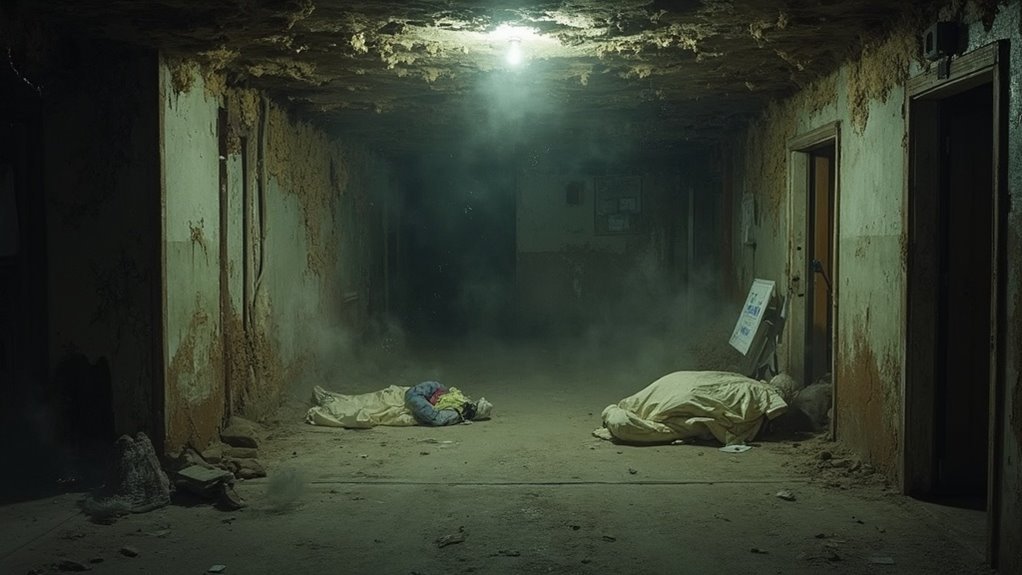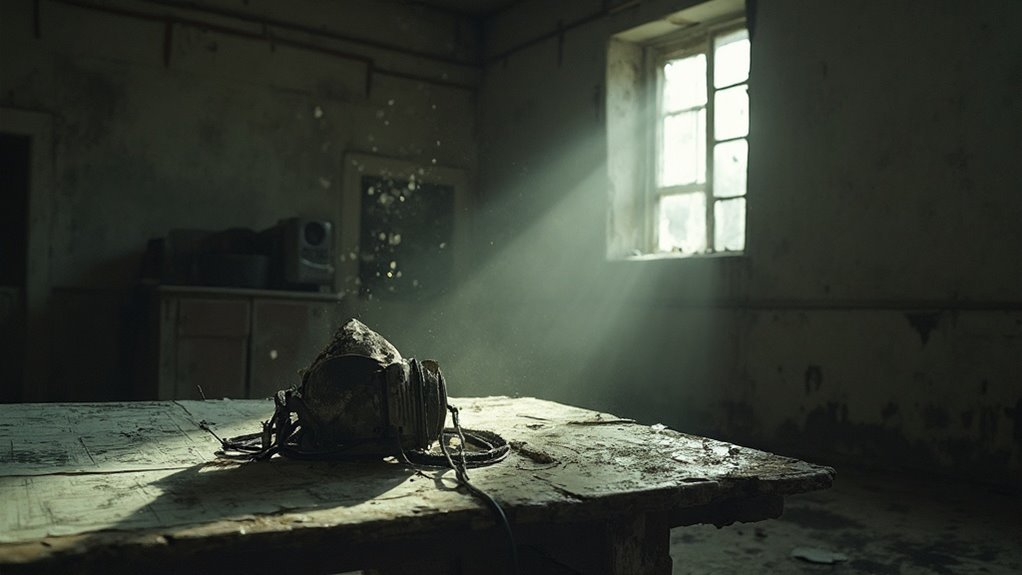Neglecting proper asbestos abatement procedures can seriously jeopardize your health. Asbestos fibers become hazardous when disturbed, releasing them into the air, where you can inhale them. Exposure can lead to severe conditions like asbestosis, lung cancer, and mesothelioma, often emerging decades later. You must be aware of regulations requiring licensed professionals for inspection and removal. Common violations, like improper waste disposal and inadequate safety measures, further increase risks. Regular health monitoring is vital to catch any issues early. Staying informed about safe management practices and professional standards is imperative for protecting yourself and your environment. There's much more to uncover.
Understanding Asbestos Risks

Understanding the risks associated with asbestos is vital for safeguarding health in both residential and commercial settings. Asbestos poses significant dangers primarily when its fibers are disturbed and released into the air. Consequently, the mere presence of asbestos isn't hazardous if left undisturbed. You must implement robust building maintenance protocols to guarantee that any potential asbestos-containing materials remain intact and under control. Regular inspections using effective asbestos identification techniques are fundamental. These evaluations allow you to detect damaged or deteriorating asbestos products before they become a serious risk. When damage is extensive, removal may be necessary, but this should only be conducted by licensed professionals trained in safe handling practices. Additionally, the U.S. EPA estimates the presence of asbestos-containing materials in most schools, highlighting the need for vigilance in managing such risks.
Asbestos exposure is linked to serious health risks, making it essential to address any potential issues promptly. Abatement activities, if not properly managed, can inadvertently increase exposure risks for workers and occupants. It's vital to adhere strictly to safety regulations during any maintenance or abatement procedures. Careless actions during routine building maintenance can generate the greatest risk; thus, understanding these dynamics is paramount. By following established protocols and employing trained personnel, you can effectively manage and mitigate asbestos risks, guaranteeing a safer environment for everyone involved.
Health Impacts of Asbestos
As you consider the health impacts of asbestos, it's vital to recognize both the immediate and long-term risks involved. Prolonged exposure can lead to severe conditions like asbestosis and lung cancer, while even short-term contact may trigger acute respiratory issues. Understanding these risks helps you appreciate the urgency of proper asbestos abatement practices. Moreover, even low-level exposure can be harmful, underscoring the importance of safe handling and removal.
Long-term Exposure Risks
Many individuals underestimate the severe long-term health risks associated with asbestos exposure. Prolonged contact with asbestos can lead to a range of debilitating diseases, including lung cancer, mesothelioma, and asbestosis. The risk escalates with the duration and frequency of exposure, meaning that even a brief encounter can have lasting implications, especially for those with pre-existing lung conditions or a history of smoking.
Asbestos awareness is fundamental for exposure prevention. It's important to recognize that asbestos-related diseases often take 15 to 30 years to manifest, creating a lag period that can lead to complacency. Common issues like pleural disorders and potential digestive cancers highlight the need for vigilance.
If you suspect asbestos in your environment, don't disturb it. Leave it undisturbed if it's in good condition, and seek professional help for any repairs or removals. Regular inspections and health monitoring are significant steps in safeguarding your health. By understanding these long-term risks, you can take proactive measures to mitigate exposure and protect yourself from the serious consequences of asbestos-related diseases.
Immediate Health Effects
Exposure to asbestos can lead to immediate health effects that may go unnoticed initially but can have serious implications for your well-being. When you inhale asbestos fibers, you might not experience acute symptoms right away, but the risks are substantial. Symptoms like chest pain, persistent cough, and shortness of breath can indicate a hazardous reaction.
Here's a quick overview of immediate health impacts:
| Immediate Response | Symptoms |
|---|---|
| Inhalation of fibers | Chest pain or tightness |
| High concentrations | Crackling sound in lungs |
| Respiratory complications | Persistent cough |
| Shortness of breath | Respiratory distress |
| Environmental exposure | Potential pleural effusion |
Understanding these acute symptoms is essential for your health. If you notice any of these signs, seeking medical attention promptly can lead to better outcomes. Remember, while the effects might seem minor at first, they can evolve into serious conditions like asbestosis or even lung cancer over time. Stay vigilant and prioritize your safety in environments where asbestos is present.
Key Abatement Regulations

Maneuvering through the intricate terrain of key abatement regulations is essential for anyone involved in asbestos management and removal. Understanding these regulations not only guarantees compliance but likewise protects public health. Here are some important aspects to take into account:
- Notification Requirements: You must notify relevant authorities before any demolition or renovation work involving asbestos-containing materials.
- Threshold Amounts: Be aware that notification is necessary for projects exceeding 260 linear feet or 160 square feet of asbestos.
- Inspection and Training: Licensed inspectors must assess asbestos conditions, and all professionals handling asbestos must undergo accredited training programs.
Both federal and state regulations dictate specific abatement procedures. Non-compliance can lead to severe penalties, including fines and legal action. It's critical to adhere to practices such as wetting asbestos to prevent fiber release, using HEPA filtration during clean-up, and guaranteeing proper disposal in authorized facilities. Regular inspections are likewise important to maintaining compliance with asbestos regulations. By staying informed and vigilant about these regulations, you can greatly mitigate health risks associated with asbestos exposure.
Common Abatement Violations
When overseeing asbestos abatement, you must be vigilant about common violations that can jeopardize safety. Inadequate safety equipment, improper waste disposal, and a lack of notification to relevant authorities are frequent issues that can lead to serious health risks. Addressing these violations is crucial to guarantee compliance and protect both workers and the surrounding community.
Inadequate Safety Equipment
In the domain of asbestos abatement, inadequate safety equipment poses significant risks to workers' health. When you consider the significance of proper PPE standards, the implications of neglecting safety measures become alarmingly clear. Without appropriate equipment, workers are exposed to hazardous asbestos fibers, which can lead to severe health issues.
Here are three vital areas where safety equipment often falls short:
- Inadequate respirators and face masks that fail to filter asbestos fibers effectively.
- Insufficient use of disposable coveralls, gloves, and eye protection, leaving skin and mucous membranes vulnerable.
- Lack of regular inspections to verify the quality and maintenance of existing PPE.
Furthermore, inadequate hazard training intensifies the problem, as workers may not understand how to use their PPE properly or grasp the risks they face during abatement procedures. Without thorough training, they may not follow necessary protocols, increasing the likelihood of exposure. To promote a safer workplace, it's essential that all workers receive the proper equipment, training, and ongoing monitoring. Ignoring these aspects not only jeopardizes their health but also undermines the entire abatement process.
Improper Waste Disposal
Improper waste disposal of asbestos-containing materials presents serious risks that extend beyond the immediate worksite. Many construction sites neglect proper waste management protocols, often placing hazardous materials in regular trash or open dumpsters. This blatant disregard for asbestos regulations can lead to significant environmental and health repercussions. The EPA mandates that asbestos waste be contained in sealed, leak-tight containers with appropriate labeling, ensuring safety during transport and disposal.
Unfortunately, companies frequently violate these regulations by disposing of asbestos in landfills not designated for hazardous waste. Inadequate documentation of the disposal process further intensifies the problem, making it difficult to trace and rectify issues.
The consequences of such violations are severe, including hefty fines, increased cleanup costs, and potential legal action. Additionally, improper disposal heightens the risk of asbestos exposure to both workers and the public, leading to long-term health issues and environmental contamination. Adhering to proper waste management practices is not just a regulatory obligation; it's a critical step in protecting public health and the environment from the dangers of asbestos.
Lack of Notification
Failure to properly notify relevant authorities about asbestos abatement can lead to significant regulatory violations, jeopardizing both public safety and project integrity. Without timely notifications, you face serious notification consequences, including hefty fines and legal repercussions. It's vital to understand the specific requirements and deadlines for notifications to guarantee compliance.
Key aspects of proper notification include:
- Timing: Notifications must be submitted at least 10 working days before starting any abatement or demolition work.
- Documentation: Required documents include asbestos inspection reports and laboratory analytical results, even when no asbestos is detected.
- Separate Notifications: Different notifications are needed for renovations and demolitions at the same site.
Adopting effective compliance strategies is imperative to avoid penalties, which can range from $1,200 to $10,000 per infraction. Noncompliance can lead to severe fines and health risks from potential asbestos exposure. Additionally, your company's license may be at risk if violations occur. By following proper notification procedures, you protect not only your project but likewise the health and safety of workers and the surrounding community.
Sources of Asbestos Exposure

As you navigate the terrain of asbestos exposure, it's vital to understand the various sources that contribute to this significant health risk. Occupationally, workers in construction, demolition, and manufacturing of asbestos-containing products face heightened exposure. Asbestos regulations often dictate safety measures, but enforcement can vary, leaving workers vulnerable during renovations of older buildings or at sites like shipyards and refineries.
Environmental sources likewise pose risks, especially if you live near asbestos mines or processing facilities. Asbestos fibers can be released naturally from soil and rock formations, and activities like drilling can intensify this. Wind and water can transport these fibers, contaminating broader areas.
In residential settings, homes built before 1990 are likely to contain asbestos, especially in insulation and floor tiles. Renovating or disturbing these materials without proper precautions can release harmful fibers into the air.
Lastly, secondary sources of exposure can occur through contact with contaminated clothing or products, highlighting the importance of environmental monitoring to safeguard community health. Understanding these sources is vital for taking proactive steps to minimize your risk of asbestos exposure.
Safe Asbestos Handling Practices
When handling asbestos, proper training is crucial to guarantee safety and compliance with regulations. You'll need to use appropriate protective equipment to minimize exposure risks and maintain a controlled environment. Understanding the importance of regulatory compliance will help you implement safe practices effectively.
Proper Training Requirements
Proper training is vital for anyone involved in asbestos abatement to guarantee safe handling practices and compliance with regulations. Understanding the specific training requirements is imperative for minimizing health risks associated with asbestos exposure.
You should be aware of the categories of asbestos work and their corresponding training needs:
- Class I Work: Requires a 32-hour asbestos abatement worker course, focused on high-risk removal tasks.
- Class II Work: Involves an 8-hour course for certain materials, with a 32-hour requirement in Texas.
- Class III Work: Necessitates a 16-hour course, emphasizing repair and maintenance operations.
Obtaining asbestos certification through accredited training providers guarantees you have the knowledge and skills to perform your job safely. Each state typically requires workers to achieve certification, which includes passing an exam with a minimum score. You'll need to submit an application with relevant documentation, including training course certificates and employment history.
Use of Protective Equipment
Effective use of protective equipment is vital for anyone involved in asbestos handling to minimize health risks. You must wear specific respirator types designed for asbestos work, such as half-face filter respirators with class P1 or P2 cartridges, or class P1 or P2 disposable respirators. Verify that your respirator complies with Australian Standard AS1716 and displays the standard number.
In addition to respiratory protection, protective clothing is fundamental. Use disposable coveralls, hats, and gloves to prevent clothing contamination. Always fit your respirator properly to achieve an airtight seal, and follow the manufacturer's instructions for fit checks. Keep your respirator on until all work and cleanup is finished.
After work, carefully remove your protective clothing without shaking it to avoid dust release. Spray it lightly with water before removal, and immediately double-bag it in heavy-duty polythene bags. Shower and wash your hair right after finishing to eliminate any dust. Finally, thoroughly clean your hands and fingernails, regardless of glove use, to guarantee complete safety from asbestos exposure. Following these practices will greatly reduce your health risks while handling asbestos.
Regulatory Compliance Importance
Regulatory compliance is vital for anyone involved in asbestos handling, guaranteeing not only adherence to legal mandates but likewise the protection of public health and safety. Understanding regulatory frameworks, such as those established by the EPA and OSHA, is fundamental for effective asbestos abatement. Regular compliance audits help guarantee that practices meet safety standards, preventing health risks associated with asbestos exposure.
Here are some key safe asbestos handling practices:
- Wetting Asbestos: Always wet materials to minimize fiber release before and during work.
- Containment: Seal off work areas with plastic sheeting and use negative air pressure systems to filter the air.
- Disposal Procedures: Follow proper disposal methods for asbestos waste, including wet cloths and rags.
Compliance isn't just a legal obligation; it's a moral responsibility to protect everyone involved. Failing to follow these guidelines can result in significant health risks, fines, and legal issues. By prioritizing regulatory compliance, you contribute to a safer environment for workers and the public, guaranteeing that asbestos abatement is conducted responsibly and effectively.
Dangers of Disturbing Asbestos

Disturbing asbestos can release a cascade of health risks that often go unnoticed until it's too late. When you disturb asbestos materials, tiny, invisible fibers become airborne, posing serious health threats. These airborne fibers can be easily inhaled, lodging in your lung tissue and leading to various diseases. Significantly, no amount of asbestos is considered safe; all types are dangerous if breathed in.
After an asbestos disturbance, these fibers can remain airborne for days, greatly increasing your exposure risk. This makes it crucial to understand the dangers associated with any form of asbestos handling.
Asbestos exposure risks vary based on your health history, the frequency and duration of exposure, and the type of asbestos fibers involved. Thus, it's important to leave undamaged asbestos-containing materials untouched, as handling them improperly can lead to hazardous situations.
If you suspect asbestos in your environment, only licensed professionals should be engaged for testing and removal. Understanding the implications of asbestos disturbance is vital for safeguarding your health and ensuring a safer living or working environment.
Long-Term Health Effects
Long-term health effects of asbestos exposure can be insidious and devastating, often surfacing decades after the initial contact. The asbestos latency period can span 15 to 50 years, meaning that symptoms may not appear until you've long forgotten the exposure. This delay complicates early diagnosis and treatment, greatly increasing your cancer risk.
Consider the following potential outcomes of asbestos exposure:
- Increased risk of lung cancer and mesothelioma
- Development of asbestosis and other nonmalignant lung diseases
- Potential cancers in other organs, such as the larynx and ovaries
As you can see, the health impacts are severe. Inhaled asbestos fibers can irritate lung tissues, leading to chronic inflammation and serious conditions, including fatal lung cancer. Additionally, if you smoke, this risk is compounded, creating a greater-than-additive risk for lung cancer.
Always remember that the most important source of exposure today comes from legacy asbestos in older structures. Understanding these long-term effects is vital for anyone who may have encountered asbestos, as the implications for your health can be profound and lasting.
Preventive Measures to Consider

When it comes to managing asbestos risks, implementing preventive measures is essential to safeguard your health and that of others. Start with thorough visual inspections conducted by certified professionals. These experts can collect samples of suspected materials for laboratory analysis, confirming the presence of asbestos before any work begins. Conduct risk assessments based on inspection findings to evaluate exposure risks accurately.
Regular inspections are imperative for identifying signs of wear and tear on asbestos-containing materials. Avoid disturbing these materials unless absolutely necessary. Consider encapsulation or enclosure methods to manage asbestos safely without removal. During abatement, use air filtration systems to prevent the spread of asbestos fibers, and seal off work areas to contain any potential contamination.
Developing a detailed abatement plan is critical. This plan should outline the scope of work and necessary safety measures. Always notify regulatory agencies and obtain required permits before beginning any abatement work. Compliance with EPA and OSHA regulations is non-negotiable. Finally, educate property owners and workers about asbestos risks and safe handling practices to further improve awareness and safety. Implementing these preventive strategies can greatly mitigate the dangers associated with asbestos exposure.
The Importance of Training
Understanding the importance of training in asbestos management is crucial for anyone involved in activities that may disturb asbestos-containing materials (ACM). Proper training guarantees safety and compliance with regulations, greatly reducing health risks associated with asbestos exposure.
Effective training improves your ability to recognize and handle ACM, which can include:
- Awareness Training: Understanding where ACM might be encountered.
- Special O&M Training: Gaining skills needed for maintenance tasks that could disturb ACM.
- Abatement Worker Training: Learning specialized techniques for safely removing asbestos.
Certification importance cannot be overstated. It signifies that you've met the necessary training standards and are equipped to manage asbestos safely. For instance, the EPA requires 16 hours of training for school staff, and states may have their own additional requirements. Without the appropriate certification, you risk not only your health but also potential legal repercussions and fines for non-compliance.
Frequently Asked Questions
How Can I Identify Asbestos in My Home?
To identify asbestos in your home, consider professional inspections, laboratory analysis, and visual checks. Remember, asbestos testing is vital to avoid health risks associated with exposure, especially in older structures and common areas like insulation and flooring.
What Should I Do if I Find Asbestos?
Finding asbestos is like uncovering a hidden danger lurking in your home. To minimize asbestos exposure and health risks, avoid disturbing it, limit access, and hire a certified professional for safe removal or repair.
Are DIY Asbestos Removal Methods Safe?
DIY asbestos removal methods aren't safe. You risk asbestos exposure, which carries significant health risks, including lung cancer and asbestosis. It's best to hire licensed professionals who understand proper safety protocols and regulations.
How Often Should Asbestos Inspections Be Conducted?
Did you know that nearly 40% of schools have asbestos? To comply with asbestos regulations, you should conduct inspections every six to twelve months, or more frequently if materials are damaged or occupancy changes.
What Protective Gear Is Necessary for Asbestos Abatement?
For asbestos abatement, you need specific protective equipment like respirators, disposable coveralls, gloves, and goggles. Following safety procedures, including decontamination and proper disposal, guarantees you minimize exposure to harmful asbestos fibers effectively.
